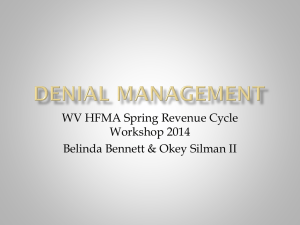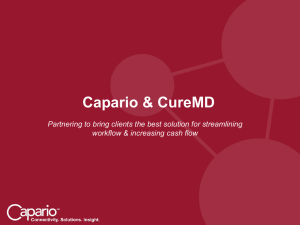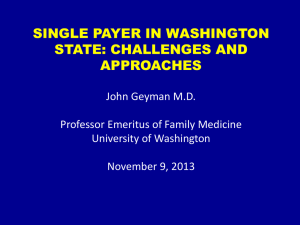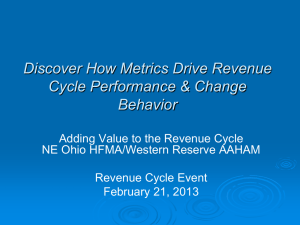AR and Effective Cash Flow Management
advertisement
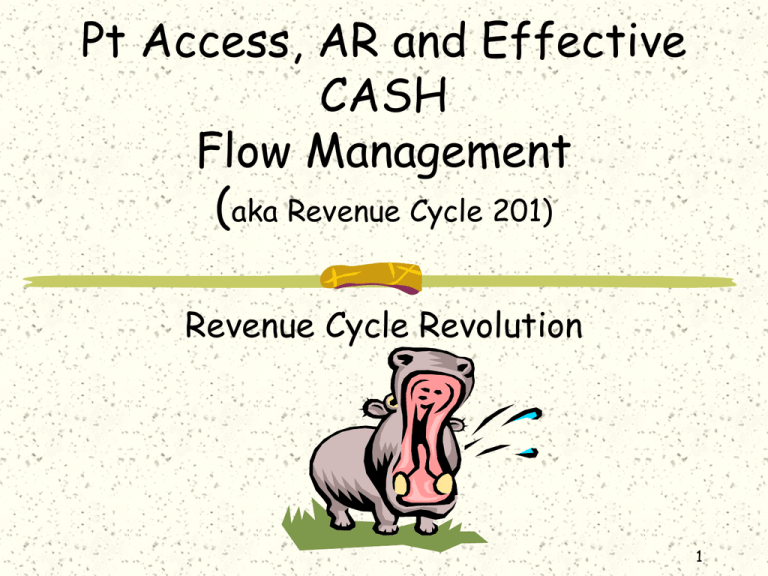
Pt Access, AR and Effective CASH Flow Management (aka Revenue Cycle 201) Revenue Cycle Revolution 1 WHAT IS “AR” AR is defined in numerous ways What will your staff understand that will help with ownership? Number of days from final billed to payment in full (at all) = complete AR ownership Number of days from discharge to PIF = shared ownership with HIM 2 Definition of Terms Admitting-Central Registration-Patient Access Scheduling – central scheduling- each dept does their own Charge capture – the process of the revenue generating departments marking charge tickets or order entry. Health Information Management/HIM – medical records Business Office – Patient Financial Services-Pt Accounting Hold days - # of days hold before dropping off the computer (usually 3-5 after d/c. Need to wait 72 hours for all Medicare accounts for non-CAHs.) 3 More definition of terms Lost charges –sent to the floor, never charged for; charted, never charged Late charges – claims dropped off IT, then charges submitted. Cost of both – if identified, adjusted bills sent to the payers. Patient receive 2 statements –from payers and facility. 4 Understanding Reimbursement Remittances –payment document from the payers What type of payment arrangements are hospitals experiencing thru contracting as well as federal and state mandated: Prospective payment systems – payment based on something besides charges: Diagnosis, CPT codes, care plans. (EX: Medicare PPS: Inpt/DRG; Outpt/APC) Fee for service – payment based on charges Per Diem – payment based on a per day rate Capitation – payment based on covered lives, per member, per month Critical Access hospitals - %billed chrgs/out; per diem/in 5 Different types of Reimbrsmnt Inpatient: Diagnostic Related Groups/DRG Uses Dx, procedures where an end coder groups into payment categories (1 payment/1 stay) Outpatient: Ambulatory Payment Classification/APC (Each CPT could be paid) Uses CPT and HCPC codes to group clinically and financially related codes into APC payment groups Skilled Nursing facilities – Resource Related Group (a # of days = 1 RUG payment) Home Health – Home Health Related Groupers (1 HHRG $ for each 60 day care plan) 6 What are the Key elements that create bad debt? Internal silos –lack of information sharing, handoffs not occurring, no cross training, lack of ownership with each dept, poor internal systems, ltd ongoing training of error education, more w/less, technology limitations, turnover..and more External demands – changing market (less liability/less travel), less elective procedures, gainfully employed uninsured, poor economy/gas or pay unsecured healthcare bills, new payer market (more Part C), complicated contracts, repeat denials/appeals…and more SO..always doing what we have always done = the same old outcome. Time to start fresh. 7 What are some Key elements to Reduce Bad Debt Exposure? Identify our new self pay patient. With insurance/large balance; Employed without insurance; unemployed without insurance. Create an environment of communication – early, during and after the encounter Create clarity on expectations Create clarity in ownership of each step within the revenue cycle –with accountability Create tracking and trending/TNT throughout the pre, during and after the visit—and ACT to change when patterns are identified. 8 Defining Our New Patient in the Revenue Cycle Unemployed with no insurance Employed with no insurance Employed with high deductible and Employed with historical insurance high coinsurance Insert into each box: 1) How pre-admission will be handled 2) Pt portion assessment 3) Financial assistance options 4) Timely follow up 9 Key owners within the Revenue cycle Pre-admission – financial counseling, scheduled admissions, verification Admission – verify all information/update Charge capture/entry – depts understand chrgs are due day of or day after. HIM – entry hold days are for coding-not charge Billing – submits a clean claim from HIS 10 More Key Indicators Insurance follow up = insurance resolution. Days to pay by payer, 30 days pay Remittance monitoring – aggressively pursue denials, develop tracking system/per payer Patient Financial Counseling – prior to scheduled procedure; verify benefits, financial statements/planning; financing options; well defined credit policy; charity policy understood 11 Redesign Revenue Cycle Opportunities - WIN 12 Better Practice Performance Indicators (David Hammer, HFMA Revenue Cycle conference) High inpt/outpt hold days 3-4 days hold High unbilled > than hold 2 days of revenue > bill hold days Excessive AR greater than No more than 15-20% in over 90 90 days days More than 6% bad debt write offs as fraction of gross revenue BD write off less than 5.25% of gross revenue; charity 2.3% (HARA 2012) Collection agency recoveries >15% Agency recoveries from 6-10% Excessive denials-$,# Denials less than 5% of net revenue Poor customer service Few customer complaints Elective surgeries-no preadmission Pre-registered and financial counseling 13 Focus on a few Key Indicators-then drill down (Day’s top 5) Establish Ave daily cash – compare to ave daily expenses, difference = margin Create internal tracking tool, post $ against goal. Research special cause variation.VISUAL Denials –both turn around days and % of net revenue Define denial vs rejection; research and resolve ‘root cause’; track by payer/reason Insurance days to pay, per payer – threshold of 30 days + aging analysis, per payer Research all reasons for ‘more than 30 days to pay”, resolveeither with payer or internal; analyze ea aging cat, focus 30-60 Registration errors – focused review with 100% accuracy on content Create training teams with BAR; review key elements of focused registrations; train and train more AR Days – gross vs net, national standard 60 gross days Understand current AR counting tool, explore coding impact; use HIPAA to move money, reduce 14 15 Making the commitment to PRE Establishing standards with multiple processes-individual pt needs addressed Eligibility verification with benefits understood (HIPAA 270) Complete authorization (coordinate with physician’s office and internal clinical staff) Schedule pre-admission financial visit (coordinate with clinical pre-admission visit. Handoffs!) Identify potential for payment. Use of a financial statement or similar tool. Use in conjunction with a credit policy-that is the beginning, not the ending point Create multiple time pay plans to meet individual pt needs. W/insurance – estimate pt portion, monitor for insurance payment, activate payment plan when insurance is received. 16 Attention to Preadmission Why isn’t every hospital doing the basics of pre-admission? Verify benefits, authorizations, preparing estimates for procedures, discussing payment plans for self pay portion including potential charity, beginning the excellent patient experience early in their healthcare encounter. “No FTEs”; “Can’t do estimates”; “Administration won’t support it “; “No space for a financial preadmission program.” 17 Idea: Service Line Deposits Preadmission – scheduled surgeries, procedures, high dollar outpt areas Create a dollar threshold that is tied to each type of scheduled environment EX) $400 Ortho outpt $500 Cath lab; $150 Endo • Incorporated into the preadmission dialogue –with or without insurance. If employed physicians, coordinate the service line deposit to include the professional component. Split the 1 payment between both based on average charges. (EX: hospital 60%, physician 40%) Staff must be trained as financial counselors –even if the registration staff is completing the above work. 18 Idea: Train thru scripting – PRE and POS Registrars must be trained on a) how to ask for money, ABNs, form completion, etc, b) how to put the pt at ease thru the process, c) how to spot potential problems and d) how to communicate all the above. Scripting- which is the written dialogue of how to do the above items – is the key to long term success. Practice, practice, practice “Thank you for choosing ABC hospital for your upcoming GI procedure (or today.) To help reduce financial surprises, we have reviewed your BC benefits and have found that there is an unmet self pay portion due from your deductible of $850 plus your plan is a 70/30 plan which means you will owe 30% after the deductible is met. Outpt balances are due in 90 days with a deposit today of $150 but if you are going to need assistance I would be happy to schedule an appt with the financial counselor of the hospital.” Lots of variations 19 Hospital ideas Paro scoring used extensively with self pay patients. (Karla Carter, Dir PFS, MVRMC/St Luke’s, TF, Id) 98% of all scheduled services will be fully secured prior to the patient arrival. (Providence Health System, ANI 2008, Teresa Spaulding, Adm, Ore) Research all denials for authorizations and incorporate into PRE standards. (Judy Veazie, consultant) 20 More Pre-admission ideas OB classes – examples of pt claims (mom and baby) with estimates (well baby, C/S, vaginal delivery), information on financial assistance, unique coverage issues for the area, payment plan options Surgery Scheduler – outline key elements needed to begin the pre-authorization, eligibility and pt contact steps. Eliminate rework of calling the office, patient, etc to get the initial information. 21 Looking at Point of Service With an aggressive Pre-admission program, only direct admits, low dollar outpt and ER will be ‘unknown’. Set the expectation of Payment… Dear Valued Patient letters Posted signs on payment due at time of service –with assistance if necessary Train registration staff on standards, scripting Create service line deposit. (EX $100 MRI) 22 More Point of Service Ideas Are you ready to provide the pt a bill at discharge? What needs changed to be able to do this or an estimate? How is late activity tracked and trended? How are hold days in HIM evaluated and trended? Can you do an estimate of amt due with insurance interface? (real time adjudication) 23 Next Steps in the AR AdventureTRACK N TREND (TNT) Review remittances Track denials by payer, by volume, by reason Track delays – by reason: records, etc. Review late charges/lost charges Track by dept Educate and reduce Review opportunities from RAs, billing rejections, manual changes to UB/1500 All manual changes need eliminated/greatly reduced=compliance and labor intensive Identify internal ‘next steps’ to attain 5 key indicators – then keep going! 24 More Next Steps Look at individual areas: Admitting, HIM, billing, ins resolution and collection. Then create measurements for each area Finally, roll out HIPAA transaction sets to find the three wins EX of area specific standards: # of days to code = 3-5 within the hold days. Track by reason, by physician delays beyond. Also # of days paper records: floor to HIM, to prep, to code. # of days to submit a clean claim= 0. Track all manual interventions with delays. # of days to submit to 2nd payer after primary=1. Determine manual vs electronic, use HIPAA 837 25 And don’t forget the patient! Not the biggest cash impact but biggest staff time; biggest long term success At point of initial service, establishPositive impression Big White Hat –here to help! Establish a communication channel Set expectation of payment –with financing plans Dear Valued Patient letter 26 Dear Valued Letter Sample Every registration, every time Dear Valued Pt- Thank you for allowing ABC hospital to serve your health care needs. To eliminate financial surprises, below is pertinent information related to your visit. If you provide current insurance, we will be happy to bill it on your behalf as there are specific codes that are required for accurate and timely billing to your payer. You will receive bills from other providers. (List them) All balances are due within 90 days from date of service. If you will have problems meeting that requirement, please call our financial counselors 1-800-333-3333 for financial assistance. Are you a Medicare patient? Any oral medications given in an outpt setting are not billable to Medicare as hospitals are not covered under the Part D benefit. Ask us if you have questions. Again, thanks for allowing us to service you. Signed: Director PFS or similar leader 27 Common questions in AR management Q: What % of the pt portion balance would you expect as a standard payment? A: Tough as each pt will need their financial ‘ability to pay’ reviewed thru the use of a financial statement. Using credit policy as the guide, determine the pt’s ability to resolve the balance within credit policy. If they cannot, begin the process to determine what their ability is to pay the balance. Identify expenses vs disposable income left to pay the balance. Identify expenses that could be reduced or that may be paid off soon – adjust payment to reflect new disposable income as it becomes available. Utilize the financial assistance policy to determine if additional reductions can be made on the balance. Sliding scale, partial reductions, etc. 28 More fun questions Q: A: When does the value of the balance drop? Historical information has shown that the balance looses value after it is 90 days old. Usually drops to $.10 on the dollar. Hey, why are some providers/facilities waiting until 90 days to begin working on the acct? Huge opportunity to reduce bad debt and improve patient satisfaction thru reducing their unplanned financial surprises thru Pre-Admission, estimates, eligibility verification, and financial discussions prior to any procedure or immediately post ER visit. Most patient’s pay because they feel we care…not because we have a hammer 29 Post Encounter Ideas Timeline for ongoing, rapid insurance resolution. Timeline for ongoing follow up to patient/family on the outstanding balance. Use skip tracing/similar information on addresses Family billing for the entire history vs pt specific Use matrix concept: will pay, could pay, won’t pay= different efforts, letters, etc. Different efforts on different balances. (EX: $250 = 1 call, 1ltr; $500 =2 calls, 2 ltrs) 30 What to Outsource? Statements Follow-up – Early out Phone contact & payment arrangements Overflow arrangements for phone answering Charity screening Applications for Public Assistance Longer term financing All self pay collection activities from Day 1 Revenue and Reimbursement Boot Camp 31 How to Outsource? Fee for service arrangement Commission on collections as they are made Incentives for quicker collection or improved collections Get the cash now Sell the Bad Debt Sell all Self Pay A/R Revenue and Reimbursement Boot Camp 32 Bad debt ideas Pre-collect letter – from hospital’s legal counsel or collection agency. “One last chance” Paro/credit scoring used in conjunction with collection agency work. Require skip tracing to be done by agency Develop a collection agency report card Includes % rate, with legal separated Includes pt complaints Includes onsite visits Includes reports with historical patterns Includes any accounts that were turned with insurance pending Includes required incomplete information 33 Resources to ‘get it right’ (Providence Health Services) Zillow.com /property eval=free County websites/property eval=free Accurint.com/property/ address/skip=cost • USPS.com/address = free • Online credit bureau/financial eval=cost • MySpace.com/skip tracing = free Free address and phone #including reverse directories Anywho.com Thephonebook.com Yahoo.com Switchboard.com Addresses.com Go411.com (candian) 34 35 Admitting Quality Program Do you audit for accuracy? What is the criteria to know it is right or are the blanks just filled in? What type of error education is occurring? Evaluate the value ofauditing all pt types or audit high risk areas. EX) ER night shift, ER weekends = high risk areas. Rotate out of these isolated shifts infrequently. 36 Better practice ideas Verify benefits/demographics = Pre and again post 90 days, prior to turning to collection (Providence, Ore) Run all self pay thru Medicaid eligibility – prior to charity, prior to turning to bad debt. Actively involve nursing/scheduling with identifying potential problems – OB, procedures, case mgt, etc. 37 More better practice ideas Service line deposits in all areas: a) pre/scheduled, b) point of service/outpt, ER with consistent credit policy standards but flexible as necessary. Scoring on ‘collectability’ prior to performing collection activities Pre-collect letters prior to collection agency full referrals (MVRMC) Refer to Budget Counselors as an alternative (Veazie) 38 Denial prevention- Tracking and Trending Using the Remittance Advice + input from employees + patient concerns and complaints = identify patterns. Denial tracking and trending is about preventing, not monitoring. Change the process. (Ex: Medicaid Name & #. Aggressively audit all pre-registered plus day of service registrations. Implement 270/automated eligibility for all registrations.) 39 Ideas to audit Days to pay per payer, per type Manual edits to claims from the main frame-who and why Charity policy implementation Sign off authority for write offs Reason for ‘hold’ in HIM beyond computer generated/mandated hold days Denial or partial payment patterns from RAs 40 Focus on Patient Friendly HFMA’s Project Recommendations Customer Service Standard Advance Information to Patients Measure Success Patient Friendly Billing Guidelines Coordination Information Gathering Simplify Contractual Relationships Consolidate Billing Standardize Written Communication 41 More Patient Friendly Ideas Use Understandable Terminology Rethink: ‘This is not a bill.’ Bill Patient After Insurance Has Paid Concise Financial Communication Understandable CDM Provide On-Line Capabilities www.patientfriendlybilling.org 42 43 Technology Ideas Computer integrated/bolt on pt and/or insurance payment ‘estimator.’ Excel with high volume procedure priced and integrated into letter to send to pts. Review Agency reports for patterns HIPAA standard transactions Eliminate manual interventions –with 44 scrubber, main IT system fixes Revenue Cycle Impact of HIPAA HUGE WINS thru complete rollout Eliminate/reduce denials Move money more rapidly Increase productivity of staff Redesign business process Now let’s discover how… baby steps… 45 HIPAA Tx & Code Sets impacts: All health plans (Medicare, Medicaid, BC, BS, employer-sponsored group health plans and other insurers companies, and networks: except WC and liabilities) All providers (physicians, hospitals, and others) who conduct any of the HIPAA transactions electronically. PURPOSE: To create a single standard for claims, eligibility verification, referral authorization, claims status, remittance and other transactions. 46 HIPAA: The EDI Standards Transaction Standards: Eligibility: ASC X12N40101A 270/271 Referral & authorization: Claims: ASC X12N40101A 278 Institutional (837I) Professional (837P) Dental (837D) ASC X12N40101A 837 Claim Status: ASC X12N40101A 276/277 Payment & remittance: ASC X12N40101A 835 Enrollment/disenrollment: ASC X12N40101A 834 Premium payment: ASC X12N40101A 820 First report of injury & Claims attachment - forthcoming 47 HIPAA TRANSACTIONS FLOW 48 Effective Denial Management Prevention is the key! Starts in Preadmission Prevent denied claims Ok, we got the denial. Now what? Get other involved.. Beyond the back end of the AR team! 49 Top Ten Reasons for Denial Coordination of benefits Patient not eligible No authorization Medical Record requested Untimely filing Additional info pending Non-covered Service Benefits expired Billing Errors Contract Review 25% 15% 15% 11% 11% 9% 7% 6% 1% .3% SOURCE: Navigating Payment Pitfalls – Healthcare Financial Mgt. 50 Of the Top Ten – Eight Addressed Type of Denial HIPAA Tx Coordination of Benefits 270 Patient not Eligible 270 Non-covered service 270 Benefits Expired 270 No authorization 278 Medical Records requested 276 Additional Info Pending 276 Billing Errors 837 51 Impact to the AR Pre-Admission – Move it up front (278,270) Eligibility- Prevent Denials (278, 270) Registration areas (“) Billing (837) Insurance follow up (276) Patient collections (271, 276, 835) 52 Work team: Insurance Resolution Objective: develop 276/277 process Team: billing rep, IT analyst, Sup/Mgr BO, PFS Director What needs done: How many days to pay Establish threshold for f/up Analyze days by payer Payer history: high maintenance vs easy/rapid Develop plan for high maintenance f/up Develop Response Matrix How are the payers utilizing the response codes? Timeframe for responses? Timelines to complete each phase: Start / finish Evolving process CELEBRATE THE BABY STEP WINS 53 AR Systems’ Contact Info Day Egusquiza, President AR Systems, Inc Box 2521 Twin Falls, Id 83303 208 423 9036 daylee1@mindspring.com www.arsystemsdayegusquiza.com Thanks for joining us! 54
